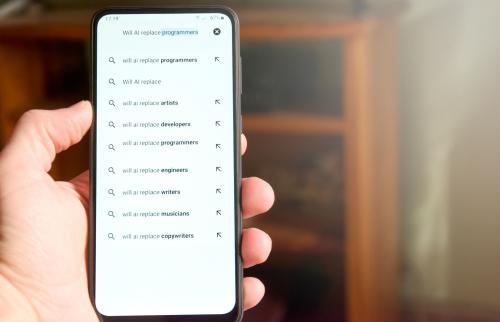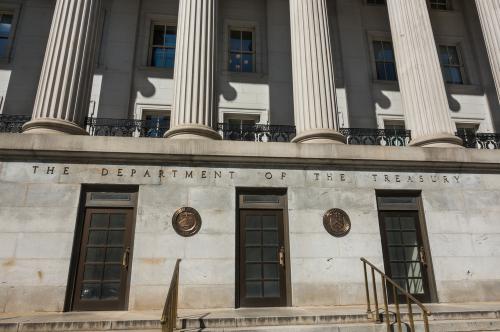What’s the latest thinking in fiscal and monetary policy? The Hutchins Roundup keeps you informed of the latest research, charts, and speeches. Want to receive the Hutchins Roundup as an email? Sign up here to get it in your inbox every Thursday.
On-line job postings lead to lower unemployment
In the last two decades, an increasing proportion of job openings have been posted online. Manudeep Bhuller of the University of Oslo and co-authors find that a Norwegian policy to expand broadband access to all households led to substantial changes for both employers and job-seekers. On the employer side, the duration of job vacancies fell by 9%, while unsuccessful hiring attempts shrunk by 13%. Unemployed job-seekers, meanwhile, found jobs 2.4% more often, and began those jobs with 6% higher wages. The authors hypothesize that these gains came because a higher proportion of the population had access to improved job search technology after the policy was implemented. Finally, the authors find that quicker and better-targeted job searches led to a 14% decrease in the steady-state unemployment level in Norway, suggesting that expanded broadband can have long-term positive effects on the broader economy.
Occupancy fraud common across mortgages
Using loan-level mortgage data matched to credit bureau information, Aaron Payne of the University of Pennsylvania and Ronel Elul and Sebastian Tilson of the Federal Reserve Bank of Philadelphia show that occupancy fraud – when investors falsely claim they are owner-occupants – represents a larger share of the housing market than previously thought. The authors estimate that occupancy fraud accounts for 6% of loans issued from 2005 to 2007 and 3% of loans issued from 2008 to 2017. Fraudulent borrowers pay interest rates 26 basis points lower and have default rates 4 percentage points higher than otherwise similar investors who do not claim to be owner-occupants. Fraudulent borrowers make up one-third of the total investor population. The authors find that the rates of fraud are roughly similar among securitized loans, loans held in portfolios, and loans guaranteed by government-sponsored enterprises. Finally, the authors show that fraudulent borrowers often default “strategically” when their equity becomes negative, which may pose a risk in future business cycles.
High administrative costs make providers less likely to accept Medicaid patients
Abe Dunn at the Bureau of Economic Analysis and co-authors find large administrative burdens associated with getting medical insurance claims paid. Using data on medical bills over the 2013-2015 period, the authors find that physicians incur administrative costs equivalent to a 17.6% loss in revenue in billing Medicaid. The costs associated with billing Medicare and private insurance are much lower, equivalent to 4.7% and 2.4% of revenues, respectively. Medicaid claims are denied more frequently than other forms of insurance. Exploiting the geographic variation in Medicaid billing costs, the authors find that a 10-percentage point increase in administrative costs makes providers 0.8 percentage point less likely to accept Medicaid patients. “We conclude that administrative frictions have first-order costs for doctors, patients, and equality of access to healthcare,” the authors say.
Chart of the week: The number of Americans without health insurance coverage has been falling
Chart courtesy of Statista
Quote of the week:
“[T]here is clearly a lot of uncertainty around the inflation outlook, and there are definitely scenarios where inflation ends up being more persistent for various reasons. Maybe we don’t see a continued reduction in some of the goods prices we’ve seen recently, or maybe some of these services prices stay elevated. In that case, we would have to be in a situation where we’d have to have somewhat higher interest rates in order to get that sufficiently restrictive stance of policy that we’re looking for to make sure that we’re bringing inflation back to 2%,” says John Williams, President of the New York Fed.
“We can take smaller steps still get to whatever we need to get to. But I think these 25-basis-point steps allow us to both adjust policy based on the new information and what’s going on and get us to our goal as we need to. Obviously, if the situation changed significantly, we would have the ability to move quicker than that or adjust course. But right now, I think the 25-basis-point increase that we just put into place seems like the right size to adjust policy, at least given what I’m seeing today… Of course, if the outlook changes – especially if the outlook for inflation were higher — you would need to have a higher interest rate to make sure that we’re getting that restrictive stance that’s bringing inflation down.”
The Brookings Institution is financed through the support of a diverse array of foundations, corporations, governments, individuals, as well as an endowment. A list of donors can be found in our annual reports published online here. The findings, interpretations, and conclusions in this report are solely those of its author(s) and are not influenced by any donation.
The Brookings Institution is committed to quality, independence, and impact.
We are supported by a diverse array of funders. In line with our values and policies, each Brookings publication represents the sole views of its author(s).







Commentary
Hutchins Roundup: Online job searches, occupancy fraud, and more
February 9, 2023